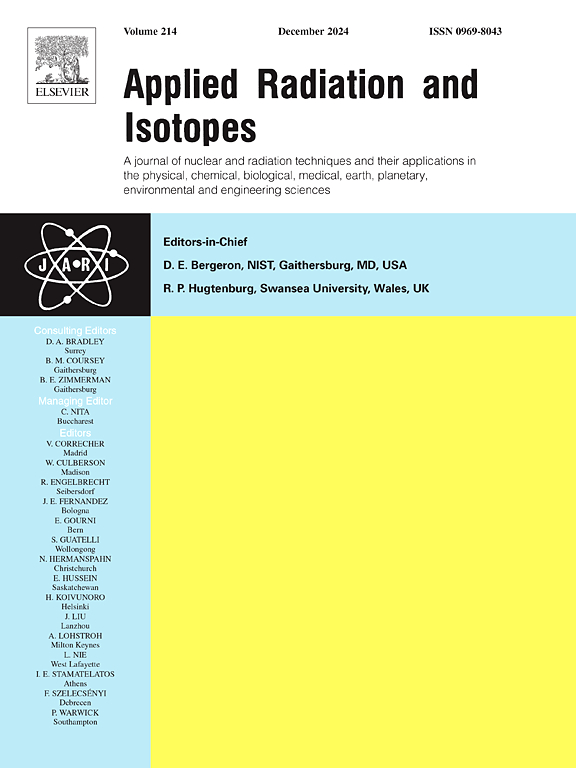Synthesis and evaluation of a 68Ga-labeled iodinated benzamide derivative as a PET imaging agent for malignant melanoma
IF 1.6
3区 工程技术
Q3 CHEMISTRY, INORGANIC & NUCLEAR
引用次数: 0
Abstract
Malignant melanoma is a highly aggressive skin cancer with increasing prevalence worldwide. The 5-year survival rate for localized malignant melanoma is 90%, but this drops to 6% if metastasis has occurred at diagnosis. Current positron emission tomography (PET) imaging probes, such as 2-deoxy-2-[18F]fluoro-D-glucose ([18F]FDG), show low sensitivity for metastatic melanoma, underscoring the need for new probes. This study explores the potential of 68Ga-labeled 2,2′,2″,2‴-(2-(4-(3-(2-((2-(5-iodopicolinamido)ethyl)(methyl)amino)ethyl)thioureido)benzyl)-1,4,7,10-tetraazacyclododecane-1,4,7,10-tetrayl)tetraacetic acid (68Ga-MI-0202F1) as a novel PET imaging probe designed for enhanced specificity and sensitivity towards melanin.
The precursor MI-0202F1 was synthesized from 5-iodopicolinic acid, 2,2′-diamino-N-methyldiethylamine, and 2,2′,2″,2‴-(2-(4-isothiocyanatobenzyl)-1,4,7,10-tetraazacyclododecane-1,4,7,10-tetrayl)tetraacetic acid ((p-SCN-Bn)-DOTA). The precursor was labeled with 68Ga in a reaction vial at 95°C and pH 5.0 for 10 min. The radiochemical purity of the 68Ga-labeled compound was determined using radio-thin-layer chromatography. Cellular uptake of the iodinated benzamide derivative was evaluated in the B16F10 cell line (mouse melanoma) following L-tyrosine treatment. MicroPET studies were conducted at 30 and 60 min post-intravenous injection of the labeled complex into B16F10 tumor-bearing mice.
The non-decay-corrected radiochemical yield was 95.96 ± 3.73% (n = 3), and the radiochemical purity exceeded 98%. In vitro studies demonstrated significantly higher uptake of 68Ga-MI-0202F1 in L-tyrosine-treated B16F10 cells compared with untreated cells. In vivo PET imaging showed rapid accumulation and sustained retention of 68Ga-MI-0202F1 in melanoma tumors, with high tumor-to-background ratios.
Overall, 68Ga-MI-0202F1 demonstrates potential as an innovative molecular imaging probe for malignant melanoma. Further studies are needed to investigate the potential of MI-0202F1 as a theranostic agent incorporating the radioisotope pairs 68Ga and 177Lu.

求助全文
约1分钟内获得全文
求助全文
来源期刊

Applied Radiation and Isotopes
工程技术-核科学技术
CiteScore
3.00
自引率
12.50%
发文量
406
审稿时长
13.5 months
期刊介绍:
Applied Radiation and Isotopes provides a high quality medium for the publication of substantial, original and scientific and technological papers on the development and peaceful application of nuclear, radiation and radionuclide techniques in chemistry, physics, biochemistry, biology, medicine, security, engineering and in the earth, planetary and environmental sciences, all including dosimetry. Nuclear techniques are defined in the broadest sense and both experimental and theoretical papers are welcome. They include the development and use of α- and β-particles, X-rays and γ-rays, neutrons and other nuclear particles and radiations from all sources, including radionuclides, synchrotron sources, cyclotrons and reactors and from the natural environment.
The journal aims to publish papers with significance to an international audience, containing substantial novelty and scientific impact. The Editors reserve the rights to reject, with or without external review, papers that do not meet these criteria.
Papers dealing with radiation processing, i.e., where radiation is used to bring about a biological, chemical or physical change in a material, should be directed to our sister journal Radiation Physics and Chemistry.
 求助内容:
求助内容: 应助结果提醒方式:
应助结果提醒方式:


